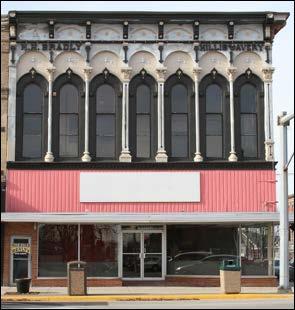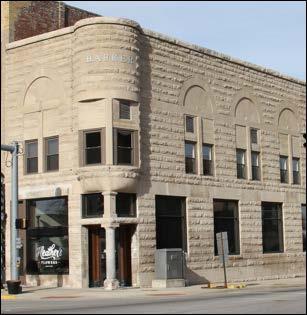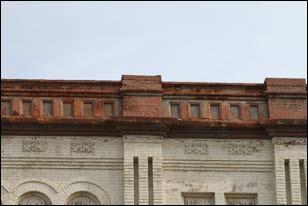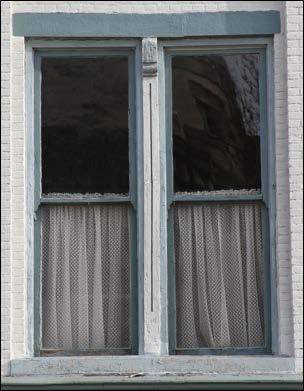
9 minute read
APPENDIX A: ARCHITECTURAL GLOSSARY
by REA site
ITALIANATE (1840-1885) Characterized by two or three stories, lowpitched roof with wide projecting eaves supported by large brackets and elaborate cornices. Balanced facades often feature decorative bracketed window and door hoods. Large storefront windows with cast iron columns.

Advertisement
facades, towers or turrets with conical roofs and porches with broad round arches supported by squat piers.
RICHARDSONIAN ROMANESQUE (1880-1900) Characterized by round arch door and window openings, rusticated block cladding, and corbel table detailing. Use of deep window reveals, asymmetrical
NEOCLASSICAL (1895-1950) Characterized by meticulous detail with causally interpreted classical ornamentation and modest scale. Door often centrally located with symmetrical window placement. Use of elements such as colossal columns, porticos, pilasters, keystones, pedimented openings and dentils along the cornice.

APPENDIX A: ARCHITECTURAL GLOSSARY
Architectural Terms
ANCHOR A metal clamp that prevents masonry from bulging, often decorative in appearance such as stars.
ARCH A curved and sometimes pointed structural member used to span an opening. Types include: flat, Tudor, pointed, segmental, etc.
BAND Any flat horizontal member that projects slightly from the surface of which it is a part; often used to mark a division in a wall.
BEAM Principal horizontal structural member, primary function to carry loads such as floor joists or rafters.
BRACKETS Projecting support members found under eaves or other overhangs; may be plain or decorated.
BRICK A usually rectangular building or paving unit made of fired clay.
HEADER Bricks laid with their short end toward the face of a wall in a horizontal position.
STRETCHER Bricks laid with their long end toward the face of a wall in a horizontal position.
BUTTER JOINT Bricks laid with their long end toward the face of a wall in a horizontal position.
CAPITAL The upper decorated portion of a column or pilaster on which the entablature rests.
CLADDING Exterior wall coverings.
19th and 20th CENTURY FUNCTIONAL (1880-1910) Characterized by a functional façade with minimal exterior ornament often limited to brickwork. Character often derived from the grid fenestration pattern featuring large windows allowing for natural light and air to penetrate the building.
COPING The protective uppermost course of a wall or parapet; projects beyond the wall surface to direct rain away from the building. Materials include: clay tile, stone, concrete or metal.

APPENDIX A: ARCHITECTURAL GLOSSARY
CORBEL A series of projecting masonry units, each stepped out further than one below it; most often found on walls and chimney stacks.
CORNICE The projection at the top of a wall; the top course or molding of a wall when it serves a crowning member. Also refers to the upper projection of the entablature in classical architecture.
FAÇADE The principal face or front elevation of a building.
FENESTRATION The arrangement of windows and other exterior openings on a building.
HOOD A protective and sometimes decorative cover found over doors, windows, etc.
Cornice.

COURSE A horizontal row of brick, stones or other masonry units.
DENTIL Small square blocks found in a series on many cornices, moldings, etc.
EAVE The portion of the roof which projects beyond the walls.
EGG AND DART An egg-shaped ornament alternating with a dartlike ornament used on a decorative band.
Window hood with keystone motif.
KEYSTONE A wedge shape stone found at the center of an arch.
KICKPLATE Material at the bottom of a storefront or door. Used as a decorative element and/or to protect glass from being “kicked”.
LINTEL A horizontal structural member that supports a load over an opening; usually made of wood, stone or steel; may be exposed or obscured by wall covering.
MORTAR A mixture of plaster, cement or lime with a fine aggregate
APPENDIX A: ARCHITECTURAL GLOSSARY
and water; used for pointing and bonding bricks or stones.
PARAPET A low wall or protective railing; often used around a balcony, or along the edge of a roof.
PEDIMENT A triangular or curved ornament above a window, door or other element.
PILASTER A rectangular column or shallow pier attached to a wall; quite frequently decorated to represent a classical column.
QUOINS The treatment of masonry joints by removing deteriorated mortar and filling in with a new mortar.

REPOINTING The treatment of masonry joints by removing deteriorated mortar and filling in with a new mortar.
STOREFRONT The front wall of the commercial space usually with large expanses of glass and the primary building entrance.
WINDOW TERMS:
APPENDIX A: ARCHITECTURAL GLOSSARY
COUPLED Two closely spaced windows that function independently but visually form a pair.

DOUBLE-HUNG A window with two sashes, each movable.
FIXED A fixed frame window that does not open.
MULLION The vertical bar between coupled window of multiple windows.
MUNTIN One of the thin strips of wood used for holding panes of glass within a window.
ORIEL A projecting bay window in an upper story of a building.
PANE A single piece of window glass. Synonym: Light
SASH The glass and framework of a window. May be moveable or fixed.
SIDELIGHT A long fixed sash located beside a door.
TRANSOM A small window above a door or other window.
APPENDIX B: FUNDING SOURCES
INDIANA HOUSING AND COMMUNITY DEVELOPMENT AUTHORITY (IHCDA): COMMUNITY LOANS
http://www.in.gov/ihcda/2374.htm
A Community Development Financial Institution (CDFI) provides capital, credit, and financial services to markets and populations that are underserved by traditional financial institutions. Communities can rebuild their physical environments and help businesses create jobs by accessing the capital and services of a CDFI.
CDFIs provide a unique range of financial products and services in economically distressed target markets, including mortgage financing for low-income and first time homebuyers and nonprofit developers, flexible underwriting and risk capital for community facilities, and technical assistance, commercial loans and investments to start-up or expanding businesses in low-income areas.
In 2010, IHCDA began incubating the Community Investment Fund of Indiana, Inc. (CIFI) with key community stakeholders such as Indiana Association for Community Economic Development IACED and Fifth Third Bank, to be certified as a statewide, non-profit CDFI. CIFI offers risk capital, loans, mezzanine financing, and other support for community revitalization initiatives, including commercial and mixeduse development, entrepreneurship and small business expansion, community facilities, and light industrial projects.
Small Business And Entrepreneurship Development
http://www.in.gov/ihcda/2351.htm
Community Enhancement and Economic Development (CEED) Loan Program
The Community Enhancement and Economic Development Loan Program (CEED) is the State of Indiana’s loan program under the Section 108 Loan Guarantee Program (24 CFR 570, subpart M). CEED provides communities with a source of loan financing for economic development, housing rehabilitation, public facilities, and other large-scale projects.
Eligible applicants include all non-entitlement Local Units of Government (including Counties) in Indiana. Funds may be used by the Local Unit of Government or lent to another public or private entity (e.g. for profit or nonprofit housing developer, an operating business) that will undertake an eligible activity.
Activities eligible for CEED financing include:
• Economic development activities eligible under CDBG;
• Machinery and Equipment;
• Acquisition of improved or unimproved real property in fee or by long-term lease, including acquisition for economic development purposes;
• Site preparation, including construction, reconstruction, installation of public and other site improvements, utilities or facilities (other than buildings), or remediation of properties with known or suspected environmental contamination;
• Clearance, demolition, and removal, including movement of structures to other sites and remediation of properties with known or suspected environmental contamination of buildings and improvements on real property acquired or rehabilitated;
• Payment of interest on the guaranteed loan and issuance costs of public offerings; and
• Payment of issuance, underwriting, servicing, trust administration and other costs associated with private sector financing of debt obligations.
Business Expansion and Entrepreneurship Development (BEED) Program
In 2010, after recognizing the need for more microenterprise opportunities throughout the state, IHCDA created the Business Expansion and Entrepreneurship Development (BEED) Program, with the primary goal of assisting and fostering microenterprise development through community lending.
APPENDIX B: FUNDING SOURCES
Pairing business counseling with financial assistance, the BEED program loans business up to $10,000 for start-ups and $25,000 to expand existing businesses. The BEED program may be paired with the Individual Development Account (IDA) matched savings program as well.
IHCDA currently works with several community action agencies around the state, serving micro-entrepreneurs in 57 of Indiana’s 92 counties. To apply, contact an agency in your area.
Usda Rural Development
http://www.rd.usda.gov/in
The USDA offers loans, grants and loan guarantees to support essential services such as housing, economic development, health care, first responder services and equipment, and water, electric and communications infrastructure. Technical assistance is also offered to help communities undertake community empowerment programs.
Community Facilities Direct Loan & Grant Program - provides affordable funding to develop essential community facilities in rural areas. An essential community facility is defined as a facility that provides an essential service to the local community for the orderly development of the community in a primarily rural area, and does not include private, commercial or business undertakings.
Rural Community Development Initiative Grants - provides funding to help non-profit housing and community development organizations support housing, community facilities, and community and economic development projects in rural areas.
Indot Community Crossings Grant
http://www.in.gov/indot/2390.htm
Launched in 2016, the Community Crossings matching grant program provides nearly $150 million in funding to cities, towns, and counties across Indiana to make improvements to local roads and bridges.
Community Crossings is a partnership between INDOT and Hoosier communities, both urban and rural, to invest in infrastructure projects that catalyze economic development, create jobs, and strengthen local transportation networks.
Home Investment Partnership Program
http://www.hud.gov/offices/cpd/affordablehousing/programs/home/
The HOME Investment Partnerships Program (HOME) provides formula grants to States and localities that communities use - often in partnership with local nonprofit groups - to fund a wide range of activities including building, buying, and/or rehabilitating affordable housing for rent or homeownership or providing direct rental assistance to low-income people. HOME is the largest Federal block grant to state and local governments designed exclusively to create affordable housing for low-income households.
HOME funds are awarded annually as formula grants to participating jurisdictions (PJs). The program’s flexibility allows States and local governments to use HOME funds for grants, direct loans, loan guarantees or other forms of credit enhancements, or rental assistance or security deposits.
INDIANA ARTS COMMISSION (IAC)
http://www.in.gov/arts/grant&programguidelines.htm
The Indiana Arts Commission is an agency of State Government funded by the Indiana General Assembly and the National Endowment for the Arts, a federal agency. The Arts Commission advocates arts development opportunities across the state, and stewards effective use of public and private resources for the arts. It stimulates public interest in, and participation with, Indiana’s diverse arts resources and cultural heritage. The Arts Commission works to enhance public awareness of the arts, life-long learning opportunities, and arts education programs.
APPENDIX B: FUNDING SOURCES
Arts Operating Support III (AOS III) / Multi-Regional: The Arts Operating Support III (AOS III) program provides two years of operating support for the ongoing artistic and administrative functions of eligible arts organizations that provide quality arts and cultural activities on a statewide or multi-regional basis, with special attention to underserved communities.
Regional Initiative Grant Program: The Regional Initiative Grant Program includes Arts Operating Support grants and Arts Project Support grants.
Arts Operating Support: The AOS grant is a Regional Initiative Grant that provides annual operating support for ongoing artistic and administrative function of eligible arts organizations that provide quality arts activities with special attention to underserved communities.
There are two AOS grant programs with different criteria needs: AOS I, an annual regional grant and AOS II, a two-year regional grant.
Arts Project Support (APS): The APS grant is a Regional Initiative Grant that provides arts project support for eligible organizations (arts or non-arts organizations). This is designed to support new and existing arts projects and activities produced or presented by eligible organizations to provide general public access to quality arts and cultural activities, with special attention to underserved communities. Indiana Masterpiece: This program supports projects that introduce Hoosiers to the best of Indiana’s cultural and artistic legacy through special productions, commissions, exhibitions, performances, and/or artistic celebrations.
Regional Arts Partner Grant Program: In collaboration with the IAC, the Regional Arts Partner program exists to promote and expand participation in the arts in Indiana. It provides broad local access to arts services and funding opportunities throughout the State of Indiana. Services include, but are not limited to, information and referral, technical assistance, and regranting of state and federal funds.
Arts Midwest Touring Fund: With funding provided in part by the IAC, Arts Midwest offers grants directly to presenting organizations (organizations that book artists to perform in their venues). Funded engagements feature public performances and community engagement activities by professional touring artists that reach underserved audiences and foster exchanges between artists and Midwest communities.
Indiana Department Of Natural Resources
Historic Preservation Fund http://www.in.gov/dnr/historic/3671.htm#hpf
Each year, the DHPA receives funding under the Historic Preservation Fund (HPF) Program, which is administered by the U.S. Department of the Interior, National Park Service. The HPF Program helps to promote historic preservation and archaeology in Indiana by providing assistance to projects that will aid the State in meeting its goals for cultural resource management.
Under the HPF matching grants program, grant awards are made in three project categories: Architectural and Historical, Archaeological, and Acquisition and Development. Architectural and Historical projects include: National Register nominations for eligible historic districts; public education programs and materials relating to preservation, such as workshops, training events, publications, and brochures; feasibility studies, architectural and engineering plans, and specifications for the rehabilitation and/or adaptive reuse of National Register-listed properties; historic structure reports for National Register-listed properties; and historic context studies with National Register nominations for specific types of historic resources.
Acquisition and Development projects include the preservation, rehabilitation, restoration, and acquisition of National Register-listed properties. This category is often referred to as “bricks and mortar money,” and is used to help save buildings and structures that are severely threatened or endangered. Note that properties not listed in the National Register are not eligible to receive federal HPF funds.



